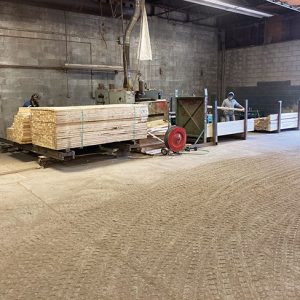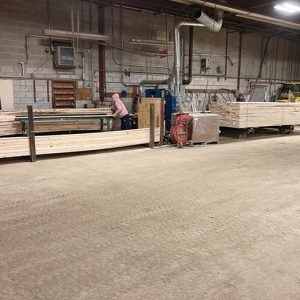
Features
Mills
Sawmilling
Site Visit
Wood Panels
Committed to growth: Monterra Lumber Mills gets an upgrade
June 29, 2021 By Ellen Cools
 An overview of Monterra Lumber Mills’ operations.
An overview of Monterra Lumber Mills’ operations. Some big changes are happening in Bolton, Ont. In August 2020, Weston Forest acquired Monterra Lumber Mills, a remanufacturing facility that has been a staple in the community for more than 30 years. Since then, the company has been modernizing the mill to boost production capacity in order to meet increased demand.
Monterra was founded by Claudio Tersigni, who continues to run the mill today under Weston Forest. The mill has a long history of partnering with different industry players, including Weyerhaeuser and Green Forest, explains Steve Rhone, CEO of Weston Forest. But, for the last 10 years or so, Tersigni was the sole owner of the business.
As demand for lumber products rose dramatically in the summer last year, Weston Forest began looking for additional production capacity to add to their existing business. Given its proximity to the company’s Toronto locations, Monterra was the perfect fit, Rhone explains.
“In addition to that, we think remanufacturing lumber, adding value, is generally a very good opportunity and an area focus for us,” he says.
Monterra Lumber Mills runs SPF lumber purchased from sawmills across North America, predominantly in Ontario and Quebec, Rhone says. Most of the wood is economy grade and No. 3 SPF kiln-dried lumber.
The mill slices and dices the lumber into as many value-added products as they can, including 1×2, 1×3, 1×4 and 2×2 material for retail distribution yards in Ontario and the U.S., along with fence boards. The byproducts are made into industrial components, including bridging stakes, pallet and industrial lumber components.
Products are shipped throughout Canada and the U.S., as far south as Georgia, with an emphasis on the Great Lakes states and Ontario due to geographic proximity.
Since acquiring the mill, Weston has boosted its production capacity from 15 million feet of finished product per year to 20 million feet.
Adding value
To produce these different products, the mill runs multiple lines.
“Primarily, our goal is to bring something in that will either end up being ripped or resawn as a first step. So, we’ll take a wide piece and make narrower strips out of it. For instance, we might split a 2×6 into two pieces of 2×3 or three pieces of 2×2, depending on what our order file calls for. Then, we’ll take it again and split it on the other dimension,” Rhone explains.
For a 2×6 that’s being turned into 2x3s, Monterra will split them into 1x3s to make strappings, he elaborates.
At each stage in the process, the lumber is culled for pieces that will not make the intended output. Those pieces are then retrimmed into lengths that will provide more value for the mill.
The mill also has a Weinig moulder line set up to produce fence boards. For this process, Monterra uses multiple 1×6 materials, in different grades, lengths and qualities, Rhone says. Those products go through the moulder, are sized and then trimmed in a trim line, mainly to five-, six- and eight-foot lengths for fence boards.
The trimsaws are supplied by a local manufacturer, while all of the mill’s ripsaws are from TOS, based in Czechoslovakia. The mill also produces bridging components and stakes using a custom-designed bridging and stake machine manufactured by Todd Engineering.
The end products are packaged based on the grade of the wood.
“With every dimension that we’re running, we target a number of different grades,” Rhone explains. “We make a superstrip (which is an almost perfect piece of wood), a premium grade, a utility-and-better grade and then an economy grade. So, we’re pulling at least four grades out of the line as we’re running material through.”
All of the wood waste, including sawdust, shavings and trimmings, is recovered and repurposed as animal bedding and mulch.
Upgrading capacity
Since Weston Forest acquired the mill, the company has added a new trim line and upgraded one of the ripsaws. They are also finalizing the installation of a new moulder, but there have been some delays.
“The biggest challenge has been getting the electrical components in on time,” Rhone explains. “Everything that we go to do seems to have some part delayed somewhere in the supply chain. So, we’re waiting on a couple of pieces, but we’re almost there and should be up and running in the next couple of weeks.”
Weston also optimized the layout of the plant, moving equipment around to make room for new machinery. Thanks to the upgrades and optimization, the mill’s production capacity has improved by five million feet per year, to 20 million feet.
To meet the high demand, the company has hired an additional 14 employees, for a total of 32 people working a day shift and an afternoon shift. The company is also looking to upgrade their resaw line, which currently uses a Baker saw, in order to further increase production capacity.
Increasing the mill’s capacity will be critical to meeting the increased demand for lumber products used in construction projects.
“We’ve been calling the demand levels crazy, insane, hard-to-believe, difficult to comprehend for almost six months now,” Rhone says. “I’ve been doing this for 34 years and I’ve never seen anything remotely like it. The things that have driven it to this stage aren’t going away quickly, so I think while nothing goes straight up or straight down, we’re in for more of the same for at least the next four to six months.”
The increased demand means a tighter fibre supply for all lumber producers, including remanufacturers such as Monterra and Weston’s other facilities.
However, “Weston has an excellent relationship with all of the mills in North America, and we’ve been a long-term, well-established customer, so I think we get at least our fair share of what’s available,” Rhone says. “We haven’t run out of anything, but it has certainly been a very tight market for the last six months or so.”
A disproportionate impact
The bigger concern for Monterra Lumber Mills, and for Weston Forest as a whole, is the softwood lumber duty levied by the U.S. While the duty was revised in late 2020 from around 20 per cent to around nine per cent, “it remains pretty harsh,” Rhone says.
Lumber remanufacturers like Monterra feel the impact of the duty disproportionately, he adds. This is because they purchase lumber from sawmills as if the mills were selling that lumber directly to the U.S. Consequently, the duties those sawmills would pay on the material is added to the value of the lumber before it is loaded onto a truck. Freight costs are then added on top of that.
So, when Monterra purchases lumber, the cost is already higher than normal. Then, Monterra remanufactures the lumber into value-added products, which means they add the cost of milling and manufacturing to the price. Once that process is finished, the products are sold to customers in the U.S. and Canada. Monterra has to pay the softwood lumber duty on top of that finished price.
“So, we’re paying duty on all of our manufacturing, all of our processing, transportation and profits, which disproportionately impacts remanufacturers – not just us, but anybody who’s manufacturing lumber in Canada,” Rhone explains.
“It’s a surtax for the benefit of a very few on a commodity that is in tight supply. I think it’s a bad policy,” he continues. “Unfortunately, it’s American-driven, so we’ve got to wait for an opportunity to resolve the situation when the Americans want to come back to the table and have a conversation.”
Rhone is hopeful that the new Biden administration in the U.S. will be motivated to level the playing field and lower or remove the softwood lumber duty. He notes that, at the end of the day, it is customers – including American customers – that pay a disproportionately higher price.
Expanding footprint
Consequently, Rhone believes Canada needs to reach a long-term arrangement with the U.S. with regards to softwood lumber distribution between the two countries.
“The consistent interruptions or changes in policy every five to seven years as we go through a different lumber file is disruptive for the long-term planning of the business,” he says.
He also believes that the forest sector needs to do a better job explaining how environmentally friendly the industry is and how lumber represents a carbon capture solution.
“I think our industry doesn’t do a great job of telling that story. But, I think mass timber and the opportunity to use timber for tall wood buildings is going to be a great opportunity that we need to capitalize on as a country and as a civilization in general,” Rhone says.
Looking ahead five to 10 years down the road, Rhone believes the industry is likely to strengthen as more people realize the environmental benefits of forestry and wood products.
“I think the industry is sustainable, I think it’s on good footing, and as long as we keep our economy grinding forward, the industry should remain very strong,” he says.
This spells good news for Monterra Lumber Mills and for Weston Forest as a whole.
“We’re committed to growth. We’ve been a relatively high-growth company for the last decade, growing at about 15 per cent a year,” Rhone says. “We recently entered into a deal with a private equity company out of Boston called Watermill, who acquired our shares at the beginning of January, and our ambition is to accelerate our growth.
“We’re looking to expand our geographical footprint, both in Canada and the U.S.,” he continues. “We currently have four facilities that we own and would like to expand that in the coming years.”
This article was originally published in CFI‘s March/April 2021 issue.
Print this page

